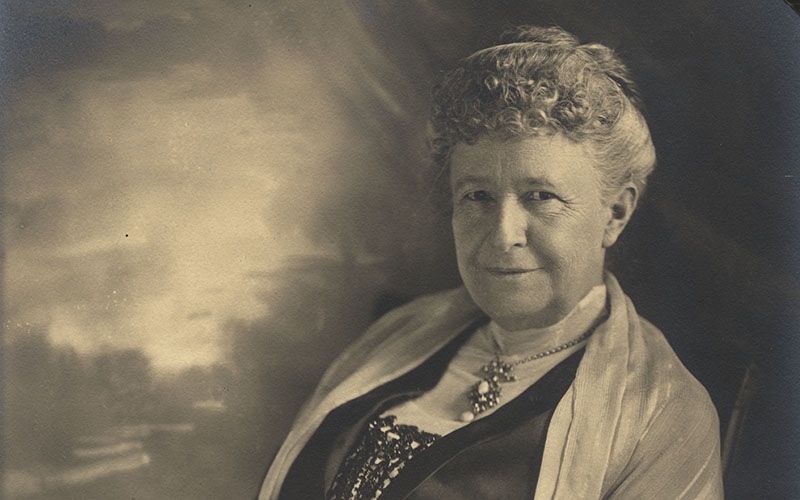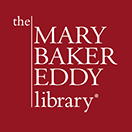Women of History: Effie Andrews

Photo of Effie Andrews. Courtesy of Longyear Museum, Chestnut Hill, Massachusetts
Effie Cochran Andrews (1848–1923) was a pioneering Christian Scientist in New York, New York. Less well-known today than Laura Lathrop or Augusta Stetson, she was involved in establishing Christian Science in America’s largest city.
Andrews belonged to a Scottish family, although records do not indicate whether or not her birth took place in Scotland. In 1867 she married James M. Andrews Jr., a Union Army veteran from Saratoga Springs, New York. They had a son, James M. Andrews III, and a daughter, Effie Rose Andrews Cochran, who helped introduce Christian Science to Scotland.1
She joined The Mother Church (The First Church of Christ, Scientist, in Boston) in 1894 and received Christian Science class instruction from Carrie Harvey Snider, a teacher who had moved to New York at Mary Baker Eddy’s request. The following year she began work as a Christian Science practitioner. She was a charter member of Third Church of Christ, Scientist, New York City, located in Harlem and incorporated in 1895. Snider and her students started this church, which relocated to Midtown Manhattan in the 1920s. Andrews would be involved with Third Church throughout her life, as its growth precipitated moves to larger spaces. “I have a place in the rank & file – which I am glad and pleased to fill,” she wrote to Eddy while serving as substitute Reader, emphasizing that Third Church’s “atmosphere of Love [was] felt and acknowledged by all.”2
In 1895 Andrews wrote to Ida S. McKinley—the wife of future president William McKinley—recommending Christian Science as a cure for Mrs. McKinley’s illnesses. She thanked Andrews for her “tender words of sympathy,” saying in reference to Christian Science healing, “I do not know whether my trouble is of the kind that will be benefitted by the treatment to which you refer, but, for the first time, I am determined to try it.” Partly by sharing her own experiences, Andrews was able to impress McKinley concerning the benefits of her faith. McKinley acknowledged that, whereas “many other friends” had failed, Andrews’s words gave her “courage and hope.”3
Correspondence from the Christian Science Board of Directors and other church officials recognized Andrews for her dedication, helpfulness, and thoughtfulness. Eddy often showed similar appreciation, once referring to her as a “grand old soldier.”4 When Andrews asked in 1896 whether it would be possible for Eddy to teach her and her daughter if she ever held another class, she responded, “Yes without a question.”5 That July Eddy wanted to see Andrews and her daughter. “Few are the hearts that meet mine as does yours,” she wrote, asking also about Third Church in New York and whether Andrews was a Reader there.6 In November Eddy was more direct: “You ought to be First Reader in your church.”7
She and her daughter did attend Eddy’s final class in 1898. That same year she asked to be made one of the First Members of The Mother Church, later called Executive Members, and was elected to this role.8. At that time The Mother Church had a Board of Missionaries—“experienced, competent, Christian Scientists” sent to various locations to “fill a vacancy, or to spread the gospel of Christian Science, or to correctly propagate this Science in whatever locality it is misrepresented, or unknown.”9 Andrews filled one-year terms between 1899 and 1903. As part of this work, she travelled 230 miles to Oswego, New York, in the summer of 1899.
Andrews published a number of articles and accounts, often in the Christian Science Sentinel’s “Letters to our Leader” feature. Responding to Eddy’s 1905 dedication address to First Church of Christ, Scientist, Concord, New Hampshire, she wrote, “I was so happy and glad over the love that illumined my thought through the words of that address, that it seemed like a Pentecostal day….”10 Her frequent correspondence to Eddy emphasized gratitude for her words and the strength she received from them.
Andrews was responsible for a number of gifts to Eddy over the years. As a member of the Daughters of the American Revolution, she gave Eddy a diamond-and-ruby pin in 1895, engraved with Eddy’s own DAR membership number (1423). She also gave a souvenir small replica of the 1893 Columbian Exhibition Liberty Bell, for which Eddy herself had donated money. On behalf of the Executive Members, she bought a silver loving cup in 1903 for Eddy’s 82nd birthday.
Effie Andrews lived in Manhattan until the time of her death, working as a Christian Science practitioner with office hours primarily at 48 W. 57th Street.
Click here for a pdf version of the finding aid for the Effie Andrews Papers on our website.
Access the Effie Andrews Papers and Effie Andrew’s correspondence to Mary Baker Eddy in our first-floor Research Room or fourth-floor Archives & Special Collections, during regular hours. Find out more about research services here.
- Mary Baker Eddy to Effie Andrews, November 1, 1898, V03012.
- Andrews to Eddy, July 20, 1896, 212.35.011
- Ida S. McKinley to Andrews, July 8, 1895, Effie Andrews Papers, LSC013.
- Eddy to Septimus J. Hanna, November 8, 1896, L05175.
- Eddy to Andrews, January 13, 1896.
- Eddy to Andrews, July 10, 1896, L10653.
- Eddy to Andrews, November 9, 1896, L10655.
- Eddy, Church Manual, 18
- Eddy, Church Manual, 5
- Effie Andrews, “A Message of Love,” Christian Science Sentinel, 6 May 1905

